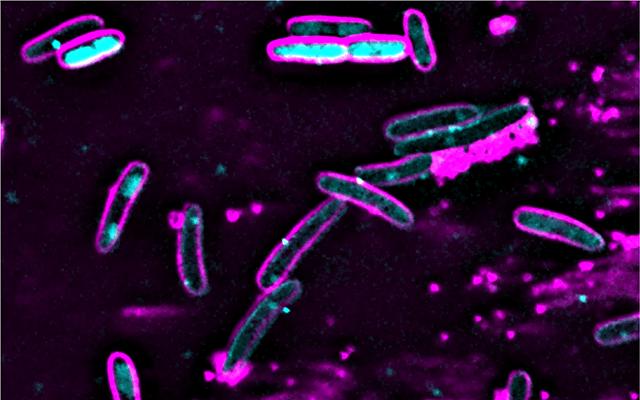January 13, 2020 -- It's already known that bacteria under assault by phages can occasionally program themselves to die before they become infected. But a pair of new papers published January 10 in Molecular Cell sheds more light on the process by which bacteria "take one for the team." The findings could provide new avenues in the treatment of multidrug-resistant bacterial infections.
Bacteria possess a variety of defense mechanisms to protect themselves against phage infection. One newly described pathway that causes death of infected cells is cyclic oligonucleotide-based antiphage signaling system (CBASS). The CBASS system can provide phage immunity by mediating a process called "abortive infection," in which infected cells die prior to completing phage replication and thereby preventing additional rounds of infection.
"Abortive infection is an old concept, but it's still controversial -- a bacterial cell essentially takes one for the team, killing itself rather than being used to produce more phages," said senior author Kevin Corbett, PhD, an associate professor of cellular and molecular medicine at the University of California, San Diego School of Medicine. "It's been debated whether or not it's logical, from an evolutionary standpoint, for single-celled organisms to do this. But if we think of bacteria as a cooperative community, a biofilm, rather than as individual cells, it makes sense."
How bacteria self-destruct
In the first publication, researchers show that CBASS defense mechanisms encode HORMA domain proteins, providing evidence that the domain proteins bind to activate cyclic GMP-AMP synthase (cGAS)/dinucleotide cyclase (DncV)-like nucleotidyltransferases (CD-NTases). These secondary messengers conjugate with HORMA domain proteins to synthesize cyclic triadenylate (cAAA), which goes on to activate the endonuclease effector NucC, causing cell death and abortive infection.
Recently, eukaryotic HORMA homologs have been identified in bacteria. The HORMA domain is a key signaling regulator during meiotic checkpoints, and these proteins have now been thought to have phage-sensing capabilities. Specifically, the first report in Molecular Cell revealed the mechanism by which HORMA proteins bind and activate CD-NTase to regulate bacterial CBASS. Bacterial Trip13-like ATPases function as negative regulators of signaling in the CBASS system. Through the HORMA/Rip3 system, Escherichia coli CBASS can sense phage proteins and initiate abortive infection.

Taking their research a step further in the second paper, the team explored if the CBASS system could be used to mediate bacteriophage immunity via abortive infection. They wanted to know how NucC activation leads to cell death and how the endonuclease is controlled by the secondary messenger.
The results indicate that, in infected cells, NucC activation leads to complete destruction of the bacterial chromosome, causing cell death prior to phage replication. NucC is a homotrimeric DNA endonuclease that binds the second messenger cAAA in a threefold symmetric allosteric pocket. Specifically, NucC trimers assemble into a homohexamer to promote double-strand DNA cleavage.
Using bacterial self-destruction
The CRISPR/Cas systems are well-characterized bacterial defense systems that use restriction-modification that rely on targeted nuclease activity. Effector nucleases are loaded with guide sequences that specifically target foreign nucleic acids. By searching gene neighborhoods of bacterial NucC homologs, the researchers identified a total of 31 distinct NucC proteins encoded within type III CRISPR/Cas systems.
From the results of this study, a new family of type III CRISPR accessory nucleases was defined. Moreover, this demonstrates that CBASS-associated NucC and NucC homolog from a CRISPR system share a common mechanism of action.
"We've studied just one of more than 6,000 distinct CBASS systems, each of which encodes a different set of infection sensors, signaling proteins, and effector proteins like the nuclease in our system," Corbett said. "Understanding how these different sets of parts work together, and how bacteria have mixed and matched them as they've evolved, will give us a more complete picture of how it all works, and how we might best intervene."
Do you have a unique perspective on your research related to bacteriology or molecular biology? Contact the editor today to learn more.
Copyright © 2020 scienceboard.net






